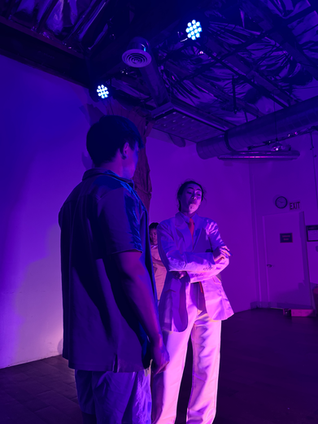Canoe, Of Land, Of Water

Treecutting, music by Zoe Lai and Felix Rosh, and The Ant Rain, projection designed by Shuwen Cao.
A multimedia one-act written by Zoe Lai
Lighting design by Szu Wang
Costume and Projection design by Shuwen Cao
Stage managed by Pam Nole
With Taehee Lee (Mush), Kosi Eguchi (Jay), and Oceane Alessandra Laurent (Crim)
Thymele Arts (World Premier)
Hollywood Fringe Festival, 2025
Two siblings struggle to learn the rules of the world when their tree mother on the home island is cut down and turned into a canoe to help them leave.
A multi-media one act exploring the tension between growth and loss, the ephemeral nature of parent-child relationships, and the ways we anchor ourselves to memory with futile attempts.
For me, Canoe was an intimate modern fable with the texture of an illustration book, and the venue happened to be a wide and shallow rectangle. Everything we see on the stage is both an image and has its corresponding event in reality on the hidden timeline. Therefore, it was very important for me to recreate the texture of the coziness and the coarseness of blurred childhood dreams, as in Marc Chagall's paintings. Through a week of workshopping with Zoe and the cast, we successfully cleared through and pinned down significant elements to the play.
The Time
The inevitability of aging was manifested through the sun's attack. Hence, in the workshop, we changed the tree cutting to the night. This way, the "status quo" started in the afternoon, the initial attack in the evening, the point of no turning back at night, and then the time jumped to the next day at noon, when the sun was at its strongest. This design created an anti-climax, as the tree-cutting was indicated by the falling rain of ants, with no performers included, thereby maximizing the kids' vulnerability in its aftermath.
The Space
The setting requires very specific movements because the allegorical space kept expanding. We have to see a tiny island with a huge tree at first, then realize there is an ocean with floating ghosts surrounding it, and finally, when MUSH agrees to leave with JAY, it has to be convincing that "the island" had been a large piece of land with a waterfall, only MUSH had denied exploring it. I enjoyed exploring the building of shapes with the casts, keeping the dramaturgical idea of expansion and opening up in mind.
The Sound
My close collaboration with Zoe Lai sparked creative connections between audio and visuals. Because of the fluid nature of mental space, we designed the soundscape's periphery to be permeable. The signifier and the signified occur in pairs; for example, each time MOTHER talks, the audience hears both the rustling of the leaves and the handpan. When both kids were completely exposed to the sun in the end, there was an actual sizzling sound of steak when JAY introduced that observation. Each piece of sound and voice in Canoe carries its own meaning and weight.

What happens to the memories about the mother and the childhood dreams when one has to grow up?
The Physicality
I wanted the characters to embrace their duality, being both imagery and characters, just as the sound lives in both worlds simultaneously.
To achieve this goal, I designed the warm-up session for this play to be 45 minutes every time we rehearsed, which was longer than my previous rehearsals. But it was necessary for the actors to use that amount of time to familiarize their bodies with their fable-like characteristics. For Kosi, JAY's springing energy upwards, and an urgency to fly away; for Taehee,
to adopt MUSH's stillness but retain the capability of fierce anger when realizing her brother's betrayal; for Oceane, the differentiation between CRIM's two statuses: rooted and calm under the sun (because CRIM had already fitted in the adult world), and her Ballet-like melancholia when she stepped into the shade of MOTHER after being in the sun for forty years.
Audience reviews
"The play has a beautiful, poetic style that masterfully blends a highly imaginative premise with grounded, relatable themes."
"A beautiful message about humanity. This is a story we truly needed, especially now."
Synopsis
MUSH always sits in the dappled shade of a willow. JAY, a migrating bird, descends from the tree’s crown like he’s always been part of its branches. He tells MUSH he’s been seeing ghosts, and the ghosts told him there’s a factory on the other side of the ocean where employees receive “horns.” The complementary horn intrigues MUSH, but she is reluctant to leave because she feels the need to stay with the tree. One day, a woman arrives on the island, smoking a cigarette. She brings in a construction team and informs MUSH that they will cut the tree down for the construction work. What will become of MUSH and JAY and the tree? What does it mean to stop seeing the ghosts in life?



